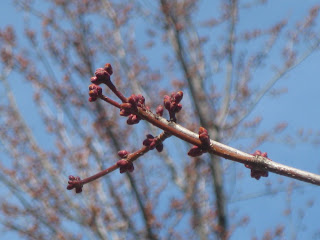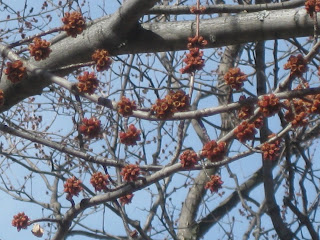When I walked by the Hudson River yesterday, I noticed two kinds of trees. One had fuzzy buds and smooth bark.
The other had furrowed bark and yellow buds.
Monday, March 28, 2011
Twigs and buds of pear and lilac
When I visited my mother's house, in her yard I observed the twigs and buds of a pear tree
and a lilac bush
I have been reading in the tree books about which trees have opposite buds. However, I have been noticing that quite a few shrubs also have opposite buds, including the lilac.
and a lilac bush
I have been reading in the tree books about which trees have opposite buds. However, I have been noticing that quite a few shrubs also have opposite buds, including the lilac.
Continuing to watch the silver maples and red maples
Thursday, March 24, 2011
Identification through the seasons
I started studying trees in summer, and it seemed the main way to identify them was by their leaves. I knew that people did identification by winter twigs, but that seemed hard, so I thought summer was really the main time you can identify trees, and the rest of the time, it's like going blind. But it turns out that fall and spring bring whole new worlds.
Last summer, I was still learning the difference between sugar maple and Norway maple. I knew that bark was different, but I didn't know if my hypotheses based on bark were correct. When fall came, I could easily tell sugar and Norway maples apart -- sugar maples were colorful while Norway maples were green, then sugar maples were losing their leaves while Norway maples were yellow. When these trees gave away their identities in fall, I then came to know which was which, and thus could see which bark was which, so now I can be more confident in my identifications based on bark.
Now has come spring. Silver maples have opened their buds to red-brown flowers, and red maples have partially open red buds. Norway and sugar maple buds are maybe swelling a little, but not doing a lot. So now, I can easily distinguish certain trees by their buds. In a cluster of silver maples, I saw one tree that had the same bark as the others, but just closed buds, so I figured it was not a silver maple but an old sugar maple. And as I walked along looking at the saplings alongside EMPAC, I hypothesized that they were sugar maples.
Last summer, I was still learning the difference between sugar maple and Norway maple. I knew that bark was different, but I didn't know if my hypotheses based on bark were correct. When fall came, I could easily tell sugar and Norway maples apart -- sugar maples were colorful while Norway maples were green, then sugar maples were losing their leaves while Norway maples were yellow. When these trees gave away their identities in fall, I then came to know which was which, and thus could see which bark was which, so now I can be more confident in my identifications based on bark.
Now has come spring. Silver maples have opened their buds to red-brown flowers, and red maples have partially open red buds. Norway and sugar maple buds are maybe swelling a little, but not doing a lot. So now, I can easily distinguish certain trees by their buds. In a cluster of silver maples, I saw one tree that had the same bark as the others, but just closed buds, so I figured it was not a silver maple but an old sugar maple. And as I walked along looking at the saplings alongside EMPAC, I hypothesized that they were sugar maples.
Wednesday, March 23, 2011
Crabapple trees
I have been wondering for a number of years about the fruit trees at work. As I wrote in November, Bob said they were "some sort of cherry or crabapple." I actually had been leaning toward crabapple, based on the bark and the twigs. Yesterday, one of the landscapers said they were crabapple. So now at last I know what they are.
Monday, March 21, 2011
Flowering!
The silver maples have flowered into little brown balls, and the red maple buds have opened up a little, but for the most part, the trees are bare an wintry. Imagine my surprise then when I was walking along Wednesday, March 16, and I saw this:
I came back Thursday, March 17 to take the photo. As far as I can tell, it's a magnolia. This one is by the entrance to the Pittsburgh building, facing south. I have noticed several other magnolia around campus which have not yet flowered, but they are not in such a sunny location.
Opposite budding winter twigs
In addition to the silver maples I saw at Peebles Island yesterday, I saw two trees with opposite buds.
There is a guide to winter twigs at http://www.ccfpd.org/NaturalResources/WinterTreeIDpocketguide.pdf which says that opposite buds can be found on the following types of trees:
Maple
Ash
Dogwood
Horsechestnut
Buckeye
Based on that web site, as well as The Sibley Guide to Trees, I think the first tree that I saw (at the top of the hill, between picnic area and shore) is probably a boxelder, because that seemed to be the only kind mentioned with white buds. The Sibley Guide to Trees says that boxelder twigs are green, bluish, or purplish. To me, these twigs are more of a red-brown.
The other thing I noticed was that over alongside the road, there was a stump with a lot of suckers growing out of it.
The stump seemed to have the diamond bark pattern seen in Norway maple, boxelder, and ash. The twigs and buds resembled Norway maple, and did not resemble boxelder and ash, so I'm thinking this was a Norway maple.
There is a guide to winter twigs at http://www.ccfpd.org/NaturalResources/WinterTreeIDpocketguide.pdf which says that opposite buds can be found on the following types of trees:
Maple
Ash
Dogwood
Horsechestnut
Buckeye
Based on that web site, as well as The Sibley Guide to Trees, I think the first tree that I saw (at the top of the hill, between picnic area and shore) is probably a boxelder, because that seemed to be the only kind mentioned with white buds. The Sibley Guide to Trees says that boxelder twigs are green, bluish, or purplish. To me, these twigs are more of a red-brown.
The other thing I noticed was that over alongside the road, there was a stump with a lot of suckers growing out of it.
The stump seemed to have the diamond bark pattern seen in Norway maple, boxelder, and ash. The twigs and buds resembled Norway maple, and did not resemble boxelder and ash, so I'm thinking this was a Norway maple.
Sunday, March 20, 2011
The silver maples have turned silver!
The silver maples have turned silver! That is, before, they had the red-brown flowers, but now there is a white or silver part growing out of it:
Tuesday, March 15, 2011
Spring emerges in red maple and silver maple
Red maple:
Red maple with sycamore in the background:
Red maple with silver maple in background:
Silver maple:
Trees in the river
These trees grow on land, except in March when the rain comes and the snow melts, the river comes up and surrounds them.
This tree is between snow and water:
Monday, March 14, 2011
Spring continues to emerge
Stephen said the red maples would be coming out, so I looked on the way home from work, and they do seem to have a little bit of something opening up. I'll try to get a closer look tomorrow. There was also one on the other side of the street opening up, but I'm not sure what kind it is, maybe ash or Norway maple. If I bring my notebook next time, maybe I can find out, since I have notes about what trees are on that stretch of road.
Saturday, March 12, 2011
Spring comes to the silver maples
My brother Stephen alerted me to the fact that this is the time of year to check the silver maples. This time last year, I did not know what a silver maple was, but now I do, and I knew exactly where to go to see silver maples.
I saw the blooming when I looked Thursday, March 10, but there was too much snow to get close to them. I took the photos Friday, March 11, when a lot of the snow had melted.
I saw the blooming when I looked Thursday, March 10, but there was too much snow to get close to them. I took the photos Friday, March 11, when a lot of the snow had melted.
Saturday, March 5, 2011
More photos from last week's trip to Peebles Island
This is my fourth and last post about last Sunday's trip to Peebles Island. The previous posts covered my observations. Now, these photos are mainly just for their beauty.
Near the start of the trail:
This tree near the start of the trail looks braided.
Two close-ups of the braided tree: one of the braided part, and one of an outstretched branch:
By the river:
The sky is so blue today.
The brown leaves indicate that this tree is an oak.
Most of the trees here are young and small, but there are a few larger, older ones. I believe they are oaks too. (I have read that the brown leaves are more common on younger oaks.)
Near the start of the trail:
This tree near the start of the trail looks braided.
Two close-ups of the braided tree: one of the braided part, and one of an outstretched branch:
By the river:
The sky is so blue today.
The brown leaves indicate that this tree is an oak.
Most of the trees here are young and small, but there are a few larger, older ones. I believe they are oaks too. (I have read that the brown leaves are more common on younger oaks.)
Trees adorned by nests and mushrooms
Reading A Guide to Nature in Winter has caused me to be more aware of nests and mushrooms on trees. I saw mushrooms once, and nests several times. It is hard to get a closer look, what with the trees being so much taller than I am. Also, the snow was deep and I had no snowshoes, so it was hard to walk anywhere other than the path, which was packed enough that I could stay on top of the snow. Thus I did not walk closer to trees that were not immediately adjacent to the path. I do have binoculars, but I haven't really gotten the knack of finding the thing I'm looking for when I look through them.
Reading A Guide to Nature in Winter also enhanced my awareness of the snow. There is a section on snow crystals, and a section on animal tracks. I saw tracks that suggested two deer may have crossed the path. I also saw some interesting patterns in the snow:
Reading A Guide to Nature in Winter also enhanced my awareness of the snow. There is a section on snow crystals, and a section on animal tracks. I saw tracks that suggested two deer may have crossed the path. I also saw some interesting patterns in the snow:
Wet tree trunks
A number of the trees that I saw last Sunday at Peebles Island had wet trunks. My theory is that it is that it had to do with the warmth causing the snow to melt and slide off the trees. I noticed this particularly in the area that was near the river. It was more noticeable in person than it is in this photo.
Subscribe to:
Comments (Atom)















































